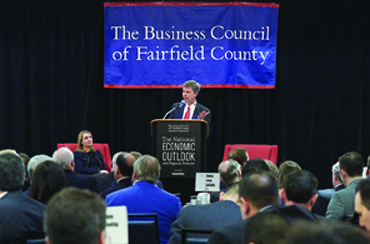The local economy may still be lagging that of the nation, but signs for both seem relatively positive as 2017 continues to unfold.
 That was the takeaway from Joseph Tracy, executive vice president and senior adviser to the president of the Federal Reserve Bank of New York, at his “National Economic Outlook and Regional Forecast” presentation held Feb. 7 at the Crowne Plaza Stamford Hotel. Sponsored by Deloitte and presented by The Business Council of Fairfield County, the nearly 60-minute presentation packed a great deal of data into a limited time.
That was the takeaway from Joseph Tracy, executive vice president and senior adviser to the president of the Federal Reserve Bank of New York, at his “National Economic Outlook and Regional Forecast” presentation held Feb. 7 at the Crowne Plaza Stamford Hotel. Sponsored by Deloitte and presented by The Business Council of Fairfield County, the nearly 60-minute presentation packed a great deal of data into a limited time.
Noting that his opinions did not necessarily reflect those of the Federal Reserve, Tracy explained how the Fed”™s two mandates are to stabilize prices and maximize sustainable employment, and then illustrated how those objectives are being realized in the current climate.
Reviewing such trends as personal consumer expenditures, inflation, the dollar”™s exchange rate, and non-oil import prices, Tracy demonstrated that the national economy is essentially where it was before the Great Recession of Dec. 2007 to June 2009; even with dramatic fluctuations in the last two categories in particular over the past few years, indications are that a period of normalcy is now in effect.
Turning to the country”™s GDP, Tracy noted that a slowdown has taken place that cannot be entirely explained away by the recession. Potential GDP growth was 2.9 percent from 2000-05, slowed to 1.7 percent for 2005-10, fell to 1.4 percent for 2010-15 and is predicted to be about 1.7 percent for 2015-20. How to grow that potential to something nearer pre-recession levels will depend greatly on the new administration”™s yet-to-be-detailed economic policy, he said.
Last year was one of modest job growth, averaging monthly gains of 180,000 jobs, but down from 2015”™s average of 225,000 jobs a month. Since the start of the recession, the U.S. has grown jobs by 4 percent and wages by 2 percent. Indications are, therefore, that companies should be looking to hire in even greater numbers rather than continue to pay current employees overtime to meet production demands.
Fairfield County, as has Connecticut at large, has trailed the country”™s recovery from the recession, though Tracy said “the past year has shown it”™s getting back on track.” He added that home prices in the county have been slow to recover, especially when compared with the New York City metro area, but noted that the county has been outperforming Rockland County in New York.
Looking at housing starts, Tracy said that the explosive growth in multifamily home construction may be reaching a leveling-off point, and that single-family domiciles will probably continue to rise. The housing bust that accompanied the recession was largely to blame or given credit for the rise in multifamily construction, he said.
Tracy said that, absent a solid national economic policy for the present, the fact that the new administration has indicated that it will take a pro-business ”“ meaning a rolling back of federal regulations, as well as a reduction in corporate taxes ”“ attitude is reason for optimism. (Trump said on Jan. 23 that he thought regulation could be cut by at least 75 percent; regarding the corporate tax rate, which stands at 35 percent at the federal level, “we”™re trying to get it down to anywhere from 15 to 20 percent,” he said.)
Tracy noted, however, that emphasis should be placed upon a sustainable growth rate rather than just one or two years of positive growth. A national sustainable growth rate would realistically be around 2 percent, he said; aiming for 3.5 to 4 percent “would be a heavy lift.”
He also acknowledged that the Fed is studying the millennial generation for broad indications of their habits regarding spending, home ownership, and the like. Noting that many millennials face significant student loan debt, he recounted a conversation he had with his 32-year-old son, who works in New York City, about the future of the family”™s home in New Canaan.
“”˜I don”™t think I”™ll ever be able to afford this house”™,” he quoted his son as saying, to which he replied: “I need you to!”


















